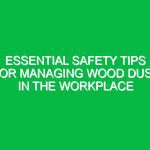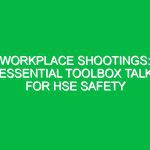Introduction to the Toolbox Talk
Good morning, team! Today, we’re going to have an essential Toolbox Talk about something that has become increasingly relevant in our work lives: Working From Home. As many of you know, remote work has its own unique challenges and Benefits, particularly regarding health, safety, and Environment (HSE) practices. It’s crucial that we take the time to understand how to create a safe and productive workspace, even when we’re not physically in the office.
Understanding the Importance of HSE in Working From Home
Let’s start by discussing why HSE practices are vital when you’re Working From Home. When you set up your workspace at home, you might not think of it as a traditional work environment, but it is just as important to ensure that it is safe and conducive to productivity. Poor ergonomics, distractions, and lack of Safety Measures can lead to accidents or long-term health issues. By implementing HSE Best Practices, we not only comply with Regulations but also foster a culture of Safety and well-being.
Identifying Potential Hazards in a Home Workspace
As we transition to a home office, it’s essential to identify potential Hazards. Here are some common risks associated with Working From Home:
- Poor Ergonomics: Using inadequate furniture can lead to back pain, neck strain, and repetitive stress injuries.
- Electrical Hazards: Overloaded power strips and improper use of electrical equipment can pose fire risks.
- Distractions: Household chores, family, and pets can divert your attention, leading to accidents or reduced productivity.
- Isolation: Working from home can lead to mental health challenges, including stress, anxiety, and loneliness.
Best Practices for a Safe Home Office
To mitigate these risks, let’s discuss some Best Practices to implement in your home office:
1. Create an Ergonomic Workspace
Your workspace should be comfortable and set up to promote good posture. Consider the following:
- Use an adjustable chair that supports your lower back.
- Position your computer screen at eye level to avoid straining your neck.
- Keep your feet flat on the ground and your knees at a 90-degree angle.
- Ensure that your keyboard and mouse are within easy reach to reduce strain on your arms.
2. Ensure Electrical Safety
Electrical Safety is paramount. Follow these guidelines:
- Check that your electrical outlets can handle the power needs of your equipment.
- Avoid using multiple devices on a single outlet to prevent overload.
- Keep cords tidy and out of walkways to prevent tripping hazards.
- Unplug devices when not in use to reduce fire risks.
3. Manage Distractions
Distractions can significantly hinder your productivity. Here are some strategies:
- Set specific work hours and communicate them to your family or housemates.
- Establish a dedicated workspace that is free from distractions.
- Use noise-canceling headphones if noise is an issue.
4. Maintain Mental Well-being
Working from home can feel isolating. To combat this:
- Schedule regular check-ins with your team to maintain communication.
- Take regular breaks to recharge and avoid burnout.
- Engage in activities outside of work, such as exercise or hobbies, to support mental health.
Real-Life Scenarios and Solutions
Let’s consider a couple of real-life scenarios to illustrate the importance of these practices. Imagine Sarah, who started working from home without any ergonomic setup. She used her dining table as a desk, leading to persistent back pain. After implementing ergonomic adjustments, such as investing in a proper chair and adjusting her workspace, she found that not only did her discomfort decrease, but her productivity increased as well.
In another scenario, John often found himself distracted by household chores while working. He decided to set specific work hours and created a ‘do not disturb’ sign for his family. This simple step helped him focus better, leading to improved work quality.
Regulations and Compliance
It’s also important to be aware of any regulations or company policies regarding Working From Home. These may include:
- Compliance with Occupational Health and Safety Administration (OSHA) guidelines.
- Adherence to company policies on remote work and safety protocols.
- Training on emergency Procedures and proper equipment usage.
By understanding and complying with these regulations, we not only ensure our safety but also protect the company from potential liabilities.
Open Discussion and Engagement
Now, I’d like to open the floor for discussion. What challenges have you faced while Working From Home? Are there specific practices that have worked well for you? Your experiences can provide valuable insights for the entire team.
Conclusion
In conclusion, Working From Home presents both opportunities and challenges, particularly in the realm of health, safety, and environment. By implementing the best practices we discussed today, you can create a safer, more productive work environment. Remember, your well-being is paramount, and taking these Precautions will benefit not only you but also our team as a whole.
Thank you for your attention and commitment to maintaining a safe work environment. Let’s continue to support one another as we navigate this new way of working!


